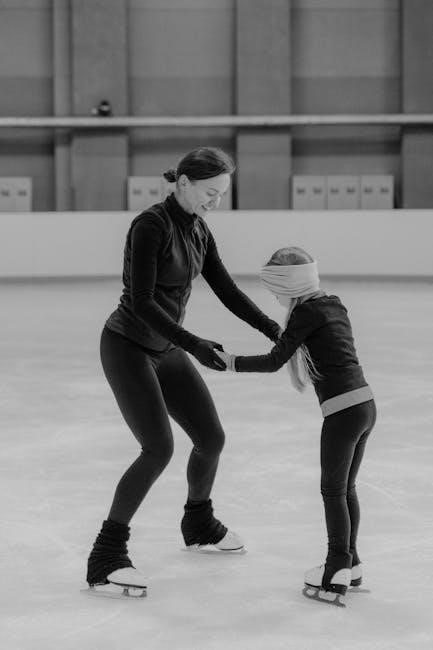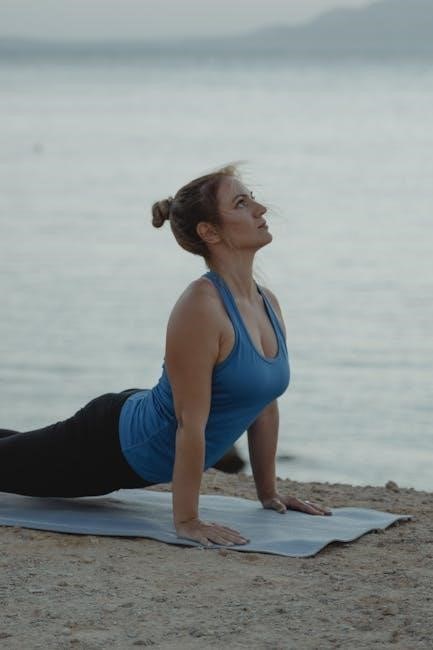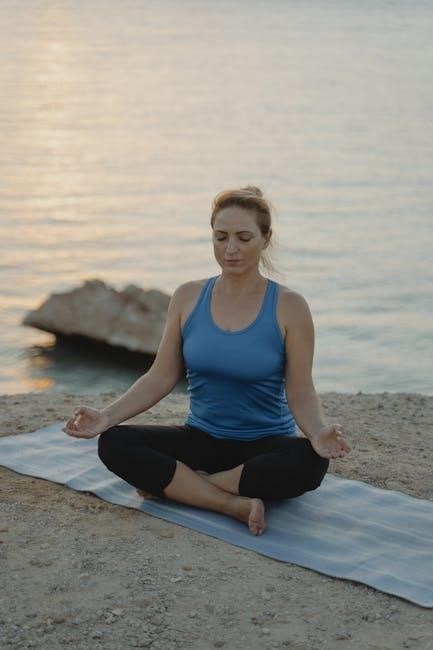Scapular Dyskinesis Exercises: A Comprehensive Guide
Welcome! This guide provides information, exercises, and precautions for managing scapular dyskinesis. It includes scapular stabilization exercises and when to seek professional help.
Understanding Scapular Dyskinesis
Scapular dyskinesis refers to alterations in the normal position or motion of the scapula during shoulder movement. Instead of smoothly gliding, the scapula may wing, tilt, or rotate abnormally, disrupting the coordinated movement between the shoulder blade and the arm. This altered movement pattern can lead to shoulder pain, instability, and decreased range of motion. It’s a non-specific response to various shoulder injuries and conditions, impacting overhead athletes and individuals with shoulder dysfunction. Proper scapular function is vital for optimal shoulder mechanics, stability, and injury prevention. Addressing scapular dyskinesis through targeted exercises and rehabilitation is essential for restoring normal shoulder function and alleviating pain.
Causes and Contributing Factors
Scapular dyskinesis arises from various factors affecting scapular control and movement. Muscle imbalances, such as weakness in the lower trapezius and serratus anterior, disrupt the scapulohumeral rhythm. Nerve injuries, like long thoracic nerve palsy, can paralyze the serratus anterior, causing scapular winging. Shoulder injuries, rotator cuff tears, or labral tears alter scapular mechanics as a compensatory mechanism. Poor posture, particularly rounded shoulders and forward head posture, contributes to scapular malposition. Thoracic spine stiffness restricts scapular movement, forcing abnormal patterns. Repetitive overhead activities, common in athletes, overload scapular stabilizers. Addressing these underlying factors, including muscle imbalances, nerve issues, injuries, posture, and thoracic mobility, is critical for effective management of scapular dyskinesis.

Diagnosis of Scapular Dyskinesis
Diagnosing scapular dyskinesis involves a comprehensive assessment of scapular movement and posture. Visual observation during shoulder movements helps identify altered scapular kinematics, such as winging or asymmetry. A thorough physical examination assesses muscle strength, flexibility, and any nerve-related issues. Specific tests like the scapular assistance test and scapular retraction test evaluate the impact of manual scapular stabilization on shoulder pain and function. Assessing posture, including thoracic spine alignment, is important. Functional movement screens identify dysfunctional movement patterns. Diagnostic imaging, like X-rays, may be used to rule out structural abnormalities. It is important to consider underlying conditions, such as shoulder injuries or nerve compressions. This thorough, multi-faceted approach ensures an accurate diagnosis.
Benefits of Scapular Exercises
Scapular exercises offer numerous benefits for individuals with scapular dyskinesis and shoulder dysfunction. These exercises improve scapular stability, enhancing control and coordination during arm movements. Strengthening scapular muscles helps maintain proper scapular positioning, reducing the risk of impingement and pain. Improved scapular mechanics leads to better shoulder joint kinematics, optimizing overall shoulder function. Scapular exercises enhance muscle endurance, allowing for sustained overhead activities. They also promote proper posture by addressing muscle imbalances. Regular scapular exercises improve neuromuscular control, enhancing the communication between the brain and muscles. By addressing the underlying causes of scapular dyskinesis, these exercises can reduce pain and improve quality of life. Moreover, scapular exercises play a crucial role in preventing future shoulder problems by maintaining optimal function.

Phase 1: Scapular Stabilization Exercises (No Arm Elevation)
This phase focuses on activating and strengthening scapular muscles without arm movement. Exercises include scapular retractions (squeezes) and protraction, emphasizing proper form to build a foundation for more advanced exercises.
Scapular Retraction (Squeezes)
Scapular retractions, often called “scapular squeezes,” are foundational for addressing scapular dyskinesis. This exercise aims to strengthen the muscles that pull your shoulder blades together, promoting better posture and shoulder stability. To perform this exercise, sit or stand tall with your arms relaxed at your sides. Gently pinch your shoulder blades together, as if trying to hold a pencil between them. Hold this position for a few seconds, feeling the muscles in your upper back engage. It’s important to avoid shrugging your shoulders upwards during this movement; the focus should be on drawing the shoulder blades back and down.
Repeat this exercise 10-15 times, performing 2-3 sets. You can do this exercise multiple times throughout the day. As you become more comfortable, you can increase the hold time or add slight resistance using a theraband. Remember to maintain proper posture throughout the exercise and avoid any pain. This simple exercise can significantly improve scapular control and reduce the symptoms of scapular dyskinesis.
Scapular Protraction
Scapular protraction exercises aim to improve the ability to move your shoulder blades forward, a crucial component of healthy scapular movement. To perform this exercise, sit or stand with good posture. Gently reach your arms forward, rounding your upper back and allowing your shoulder blades to move away from each other. Imagine trying to touch something far in front of you.
Hold this position briefly, feeling a gentle stretch between your shoulder blades. Then, return to the starting position, maintaining good posture. Avoid hunching too far forward or dropping your head. Focus on controlled, deliberate movements. Repeat this exercise 10-15 times, completing 2-3 sets. This exercise can be particularly helpful for individuals who spend a lot of time sitting or working at a desk, as it helps to counteract the effects of prolonged sitting and improve scapular mobility. Remember to listen to your body and stop if you experience any pain.

Phase 2: Scapular and Arm Exercises
This phase integrates arm movements with scapular exercises. These exercises promote coordinated scapular and shoulder function. They help improve strength and stability during functional activities.
Shoulder Blade Squeezes with Arm Elevation
This exercise builds upon the scapular retraction by adding arm elevation, enhancing coordination and strength; To perform this exercise, stand tall with your arms at your sides. Gently squeeze your shoulder blades together and downward. While maintaining the squeeze, slowly raise your arms to shoulder height, keeping your elbows straight. Ensure your thumbs point slightly outward during the elevation.
Hold the position for a few seconds, feeling the muscles between your shoulder blades engage. Gradually lower your arms back to your sides while releasing the squeeze. Repeat this movement for the prescribed number of repetitions, typically 10-15 times.
Focus on maintaining proper form throughout the exercise, avoiding shrugging your shoulders or arching your back. If you experience any pain, discontinue the exercise and consult with a healthcare professional. This exercise helps improve scapular control and upper body strength.
External Rotation with Theraband
The external rotation with Theraband exercise strengthens the rotator cuff muscles and improves scapular stability. Secure a Theraband at waist level. Stand with your elbow bent at 90 degrees and close to your side. Hold the other end of the band.
Keeping your elbow close to your body, slowly pull the band outward, rotating your forearm away from your body. Focus on squeezing your shoulder blades together slightly as you rotate. Hold the position for a couple of seconds, feeling the tension in your shoulder muscles. Gradually return to the starting position, controlling the movement.
Repeat this exercise for the recommended number of repetitions, usually 10-15 times. Ensure your posture remains upright and your shoulder blade stays retracted. If you feel any pain during the exercise, stop immediately. This exercise enhances shoulder stability and reduces the risk of injury.
Phase 3: Advanced Scapular Exercises
This phase introduces complex movements, enhancing strength and coordination. These exercises integrate trunk rotation and utilize tools like the physioball for increased challenge and stability.
Ts, Ys, and Is with Trunk Rotation
These exercises are advanced scapular strengthening movements that incorporate trunk rotation, challenging your stability and coordination. They build upon the foundational strength gained in earlier phases, promoting dynamic scapular control. These movements help integrate your shoulder with your core. This promotes more functional movement patterns.
To perform these exercises, stand upright with feet shoulder-width apart, holding light weights (optional). Rotate your torso slightly to one side as you raise your arms in the shape of a “T,” “Y,” or “I.” Focus on squeezing your shoulder blades together and maintaining a stable core throughout the movement.
Remember to control the motion and avoid shrugging your shoulders. Start with a low number of repetitions and gradually increase as your strength improves. If you experience any pain, stop the exercise immediately and consult with a physical therapist or healthcare professional. Proper form is essential to prevent injury and maximize the benefits of these advanced exercises.
Physioball Scapular Exercises
Physioball scapular exercises are a great way to improve scapular stability and strength while also challenging your balance and core engagement. The unstable surface of the physioball forces your muscles to work harder to maintain control, leading to enhanced proprioception and coordination. These exercises are particularly beneficial for individuals who need to improve their dynamic stability.
One common physioball exercise involves standing with one hand placed on the ball against a wall. Gently lean into the ball, bringing your shoulders back and down. Focus on squeezing your shoulder blades together. You should maintain a stable posture. Slowly roll the ball in small circles, controlling the movement with your scapular muscles.
Another variation involves lying face down on the physioball and performing rows or “Ts, Ys, and Is.” These exercises require a higher level of core stability and scapular control. Remember to start slowly and gradually increase the intensity as your strength and balance improve. If you experience any pain, stop the exercise and consult with a healthcare professional.
Important Considerations and Precautions
Before starting any scapular dyskinesis exercise program, it’s important to keep several key considerations and precautions in mind. First and foremost, it’s essential to consult with a qualified healthcare professional, such as a physical therapist or orthopedic surgeon. They can properly assess your condition, identify any underlying issues, and develop a personalized exercise plan that is safe and effective for your specific needs.
Always start slowly and gradually increase the intensity and duration of your exercises. Pay close attention to your body and stop immediately if you experience any pain, discomfort, or increased symptoms. Proper form is crucial to avoid further injury and ensure that you are targeting the correct muscles. If you’re unsure about the correct technique, seek guidance from a physical therapist.
Remember that consistency is key. Aim to perform your exercises regularly, as prescribed by your healthcare provider. Be patient and don’t expect immediate results. It may take several weeks or months to notice significant improvements in your scapular function and symptoms. Listen to your body, respect its limits, and prioritize your safety throughout the process.

When to Seek Professional Help
While scapular dyskinesis exercises can be beneficial, there are situations when seeking professional help is crucial. If you experience severe or persistent shoulder pain, limited range of motion, or significant weakness despite trying exercises, consult a healthcare professional. These symptoms could indicate a more serious underlying condition that requires medical intervention.
If your symptoms worsen or do not improve after several weeks of consistent exercise, it’s also time to seek professional guidance. A physical therapist or orthopedic surgeon can evaluate your condition, identify any contributing factors, and develop a tailored treatment plan. They may recommend additional therapies, such as manual therapy, modalities, or injections, to address your specific needs.
Additionally, if you have a history of shoulder injuries, surgery, or other medical conditions, it’s essential to consult with a healthcare professional before starting any new exercise program. They can help you determine the appropriate exercises and precautions to ensure your safety and prevent further complications. Remember, seeking professional help is a sign of taking proactive care of your health.
